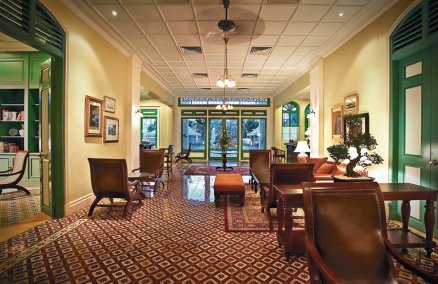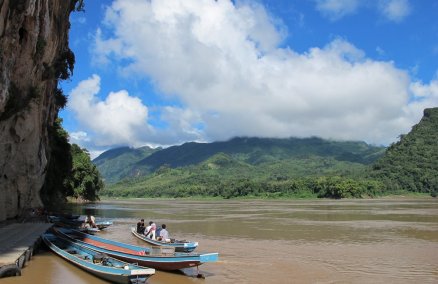One year everyone is going to Paris, the next year Bali, then Korea—what will be the next “it” destination? What about accommodation: Will we be roughin’ it in backpacker hostels or livin’ it up in luxury? And will it be planes, trains, boats or cars as our preferred means of transportation? We were curious, so we asked a few travel professionals and journalists to look into their crystal balls (globes) and tell us what to expect this year.
Boutique Hotels
Smaller-scale, fashionable and smartly designed, boutique hotels are mushrooming all around the Land of Smiles. For frequent travelers who have grown tired of the cookie-cutter chain hotels, and for a generation that places a premium on style and individuality in all aspects of their lives, these are just the ticket.
According to the Tourism Authority of Thailand’s Best Boutique Hotels online guidebook, there are now 558 hotels in the “boutique” category across the country. (Most experts would probably cut that number in at least half, however. See “Is it the Size That Matters?” next page.) From Hua Hin’s hippest restaurant, Let’s Sea, which now offers not just food, drinks and a great place to chill but also a classy place to crash, to the Dusit group with D2, their trendy residence in the heart of Chiang Mai. Major international chains already have this segment covered: It won’t be long before Bangkok sports a W, joining Dream, the Eugenia, Luxx and all the rest.
The strong point of such hotels is their style, which meets with the demands of a younger clientele who are bored with the same standard vibe and feel chain hotels have to offer. Today’s travelers enjoy a more intimate, private setting, but set in the busy heart of a city. “For the same reason you don’t want to go to McDonald’s all the time, you want something with distinct features, something individualized. That’s when boutique hotels come to mind,” Sirima Eamtako of the travel trade newspaper TTG Asia, explains.
According to Surapol Vuttivakinsakul, Brand Manager of Asian Trails, a regional tour company with offices in Cambodia, Indonesia, Laos and elsewhere, the boutique trend hit Thailand several years ago and will continue to grow over the next two to three years. “We are still in the beginning of the trend. This year there are nearly 20 new boutique hotels in Chiang Mai alone, which attract quite a large amount of tourists. But compared to Hong Kong, which is much more advanced than us in this area, there are many things we can improve to catch up, and one of them is service.”
Internationally, 2007 will see the opening of hundreds of “boutique” properties all over the world, most notably by corporate chains. Examples include the 85-room Hotel Indigo in Columbus, Ohio, by the InterContinental Group, Aleenta Soliel D’Or Seychelles and the 77-room Diamant Hotel Sydney by Eight Hotels Australia.
In Thailand, TCC Land is planning a 300-room boutique hotel renovated from the old Imperial Impala on Sukhumvit 24; Siam Motors Group is renovating the Siam Hotel on Phya Thai Road into a 209-room boutique hotel; and there is a nifty 40-room property going up on the corner of Sukhumvit Soi 16, called Maduzi (“have a look” in Thai: ma doo si) which will open next year.
Pool Villas
Isn’t it nice to swim in a stream all your own—or at least a pool? Pool villas are all the rage these days and they will become a major feature in even more 4- and 5-star hotels in 2007. Perfected by the Banyan Tree and Six Senses, pool villas offer not just a private place to splash around but more importantly matchless high-end luxury. Of course, you miss out on the hot body contest poolside, but that’s just the way it goes. You could always slum it at the common pool when you need a little eye candy. But that would be missing the point: Pool villas are for couples.
Prices start as low as B5,000 and run up to hundreds of thousands of baht per night; most are in the B10,000-20,000 range. For that, guests in a pool villa can expect a higher level of service, with amenities such as butler service, in-villa dining, in-villa spa treatments, afternoon tea and more.
The same sort of people who once stayed in suites now overwhelmingly choose pool villas (which are often suites). The 5-star guest will always choose what is more exclusive or fun, and pool villas are both. “Suites are boring,” agrees Pongpet Mekloy, the editor of the Bangkok Post travel section Horizons.
“Pool villas will grow more and more as they continue to attract both rich locals and foreigners,” Surapol says. “Compared to abroad, pool villas in Thailand are an especially good deal. For the most part pool villas here are cheaper, bigger and nicer in terms of ambiance.”
At the newly opened Putahracsa Resort Hua Hin, the owner Velvadi Sritrairatana is in the process of adding pool villas. They will be ready for guests around March next year. “I’ve seen increased demand for pool villas since I was in the planning stages of the resort. And today many guests, mostly Thai, Korean and Japanese, ask me a lot about our future pool villas,” says Velvadi.
Pattaya
One Thai destination that is expected to attract more travelers than ever before in 2007 is Pattaya. From Suvarnabhumi Airport, tourists can drive to Pattaya within an hour and a half. For Bangkokians, a new highway is being constructed for an even faster drive, expected to be finished early to mid next year.
Money has been pouring into Pattaya and the city has benefitted greatly. Its infrastructure is much improved, and it now sports a tourist bus service. The beachside walkway has been cleared and the beach umbrella and lounger scene is well-organized. Even though Pattaya beach will never be as it once was, or even a genuine rival of Patong, the facelift has made it look a lot better. Those who haven’t been to Jomtien recently will be surprised by its fresh new look, as well.
“There are more people and it looks more lively,” says Kanjana, 53, a bar owner in Jomtien, of the beach. “It’s also a lot cleaner and all the umbrellas are in good order. Sellers dress a more neatly and it’s now OK to look at again.”
What really signalled the change in Pattaya’s fortunes was the arrival of the international hotel chains. These include Amari, Sheraton, Marriott and Mercure. InterContinental will soon join the mix in Pattaya with its InterContinental Resort Pattaya, to be opened later this year, followed by Le Meridien Pattaya Resort in the beginning of 2009.
China
The most frequent international destination for Thais will still most likely be China. It’s a large country rich with culture and most importantly (let’s be honest here) cheap goods. In 2006, travel to China from Thailand was up 26.54% from 2005. And it’s said that over the next decade, China will be the second most popular vacation spot in the world, after the US.
Sirima, the TTG reporter, says that the main reason for China getting the most attention from Thai travelers is that Thais are very still cost-conscious. “What I’ve learned is that 50% of Thais consider a trip by the cost. Most of them will get on a three-day/two-night journey for around B20,000. So China has the most potential for its low cost travel. While going to Japan or Korea will cost about B35,000-40,000.”
The hype surrounding the Beijing Olympics in 2008 will contribute to the increasing popularity of China as a holiday destination. US airlines know this, and they are bidding for non-stop flights to the mainland—Northwest, United, American and Continental. Chain hotels are marching in, as well, with Starwood Hotels and Resorts Worldwide leading the pack. Rumor has it that budget airline AirAsia will have routes to China next year.
Low-cost Flying
Speaking of AirAsia, the hottest kind of transportation in 2007 will without doubt be low cost airlines. They’re cheap, they’re accessible and in some cases you can even pay for flights at 7-Eleven. The initial fear that the wings of low-cost carrier planes would fall off mid-air has worn off and people are heartily embracing this mode of travel.
OAG, a global travel and transport information company, reports that the number of low-cost airlines has more than doubled in just five years. In Thailand, AirAsia has almost doubled its passengers from 1.6 million in 2005 to 2.4 million this year. And between January and September 2006, Nok Air’s passenger count increased 20.7%.
Accordingly, low cost airlines are expanding their routes. You can now fly to Sydney and Cairns with Jetstar, to Hanoi with AirAsia, to Krabi with One-Two-Go, and next year, to the moon with Nok Air (no kidding—see “Out of This World,” page 23).
Premium Economy
Just because you can’t afford a seat in business class doesn’t mean you have to be miserable. Expect more and more airlines on more and more routes to offer premium economy class. This trend began in the US in 1999 and has expanded to Europe and other countries, including Thailand.
EVA is well-known for its premium economy, and you can now enjoy the added comfort on flights operated by British Airways, Air France, Air New Zealand, China Southern and even Thai Airways.
Though not exactly “cheap,” it’s nowhere near as expensive as business class. Those who are willing to pay a little bit more can stretch out and relax in bigger and wider seats, with more legroom, on-demand entertainment systems, a larger luggage allowance and many other privileges—some airlines even include pre-flight Champagne. A seat in the Premier Economy Class of British Airways will cost you around B34,870 (taxes and surcharges not included) from Bangkok to London, compared to B20,361 for standard cattle class.
Online Booking
Travel agents aren’t happy, but one of prime drivers of growth in the travel industry is the internet. More people are using the internet to plan and book their trips. In the case of low-cost carriers, online booking is the only way to secure those amazingly cheap fares you see advertised everywhere. Even major carriers offer internet-only rates.
Many hotels are doing the same, inviting internet geeks to visit their websites for cheaper internet rates. Dusit Best Rates guarantee that it’s cheaper than any rate you can find online, for example.
Great deals can also be found on third-party sites, such as the popular asia-room.net. At the site, you can get a B1,540 deal for single room at Central Duangtawan Chiang Mai, versus the hotel’s rack rate of B1,700.
Kattiya, 29, used www.hotelsthailand.com to get a room at Casa del Mare in Hua Hin. “I paid only B2,850 per night, while the rate the hotel quoted me was more than B4,000.”
More and more tech-savvy young people, especially, will be turning to the net instead of a travel agent. “Travel agencies will need to adjust to new technology to stay alive,” Sirima from TTG points out. As travel planning becomes increasingly self-service, it will be a case of adapt or die.
Advertisement















